Marketing and Management Strategies: Aldi Discount Supermarket Report
VerifiedAdded on 2020/04/07
|10
|2545
|29
Report
AI Summary
This report provides a comprehensive analysis of Aldi's marketing strategies, examining its background, founding principles, and international expansion. It delves into the price, product, and place strategies that Aldi employs, highlighting how they have contributed to the company's success in attracting and retaining customers. The report also explores the promotional strategies used, including brochures and social media, and discusses the application of marketing theory, value-perceived theory, and consumer behavioral theory in Aldi's approach. Furthermore, the report suggests potential marketing options for Aldi, such as online advertising, direct mail, and signage, to maintain its success and address challenges. The analysis emphasizes Aldi's focus on cost-effectiveness, customer satisfaction, and revenue generation, providing valuable insights into its market position and competitive advantages.
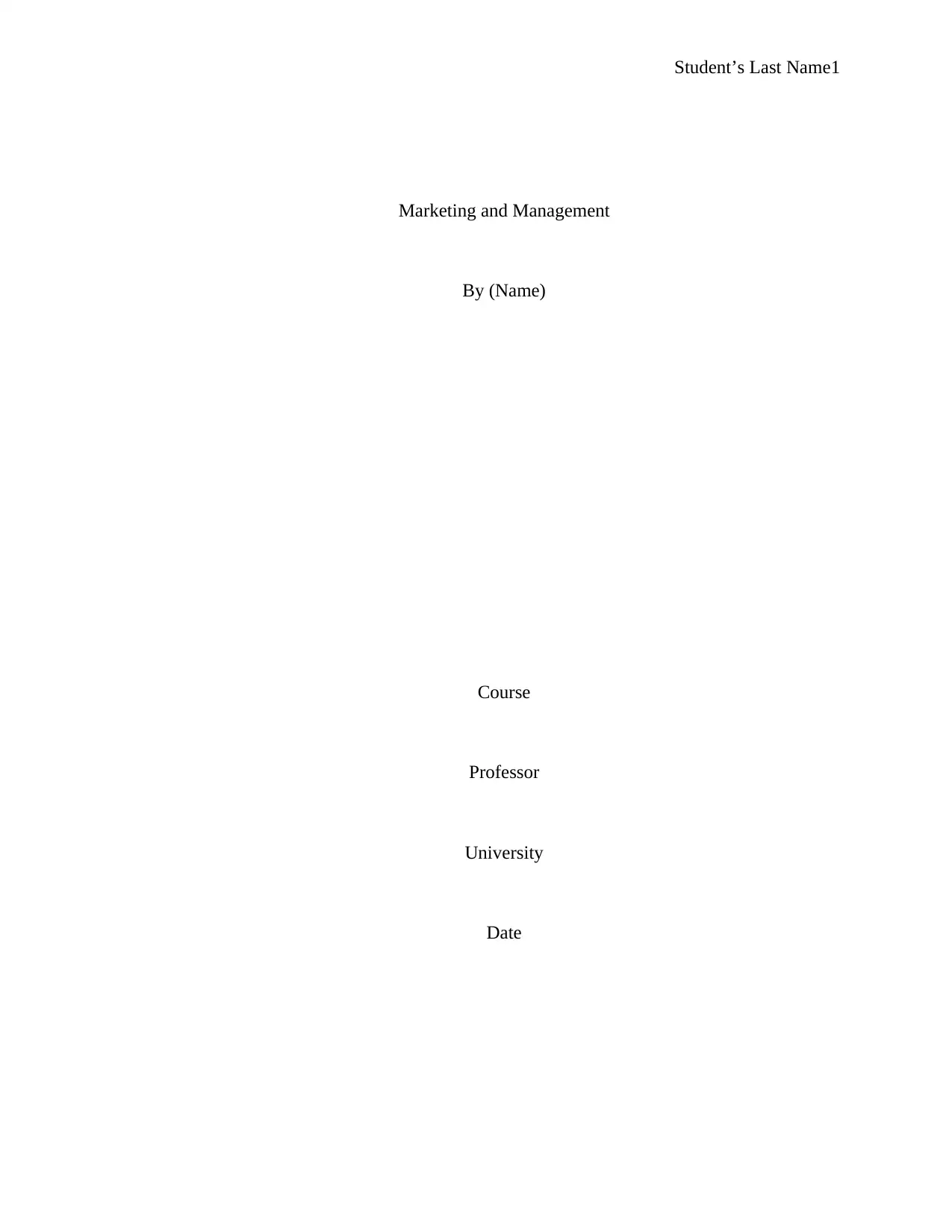
Student’s Last Name1
Marketing and Management
By (Name)
Course
Professor
University
Date
Marketing and Management
By (Name)
Course
Professor
University
Date
Paraphrase This Document
Need a fresh take? Get an instant paraphrase of this document with our AI Paraphraser
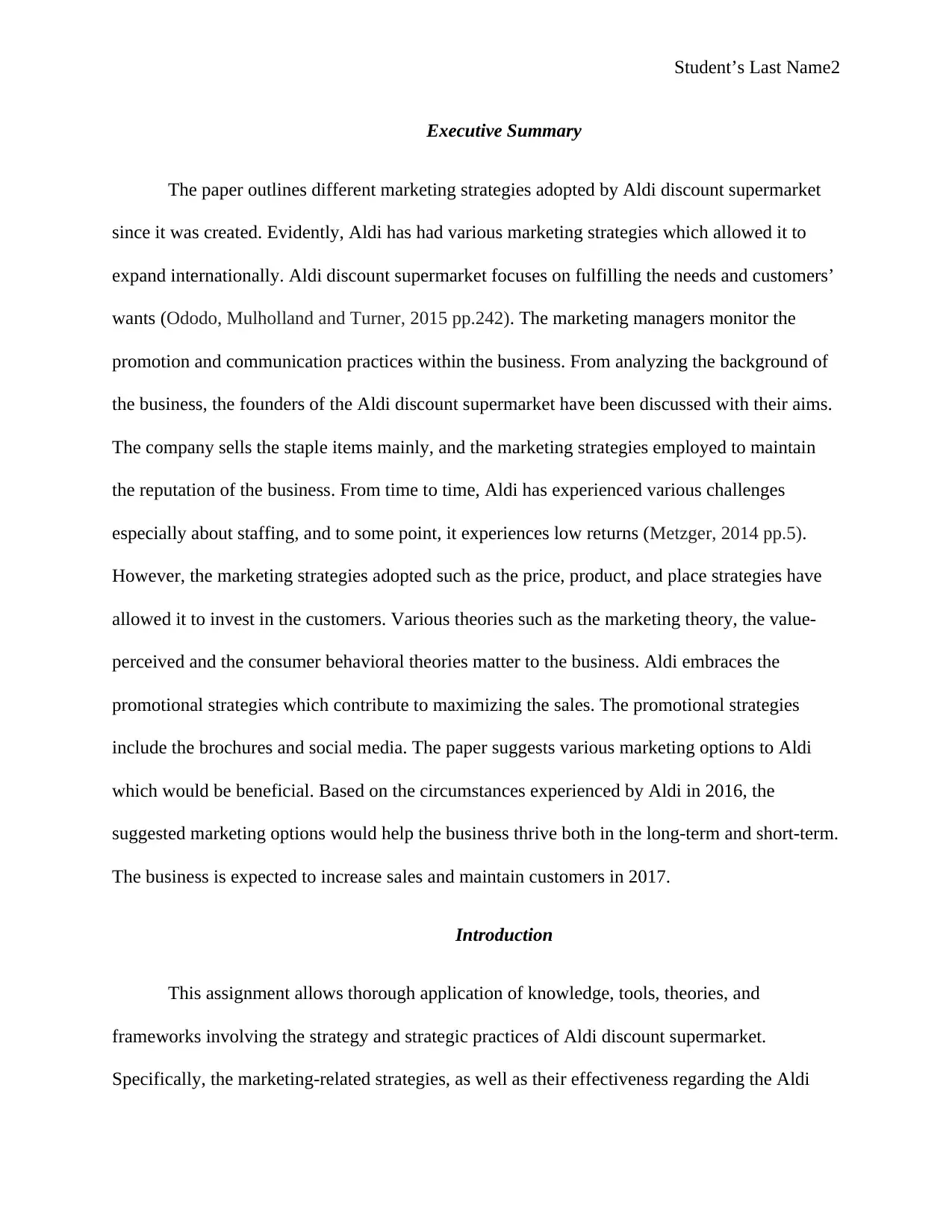
Student’s Last Name2
Executive Summary
The paper outlines different marketing strategies adopted by Aldi discount supermarket
since it was created. Evidently, Aldi has had various marketing strategies which allowed it to
expand internationally. Aldi discount supermarket focuses on fulfilling the needs and customers’
wants (Ododo, Mulholland and Turner, 2015 pp.242). The marketing managers monitor the
promotion and communication practices within the business. From analyzing the background of
the business, the founders of the Aldi discount supermarket have been discussed with their aims.
The company sells the staple items mainly, and the marketing strategies employed to maintain
the reputation of the business. From time to time, Aldi has experienced various challenges
especially about staffing, and to some point, it experiences low returns (Metzger, 2014 pp.5).
However, the marketing strategies adopted such as the price, product, and place strategies have
allowed it to invest in the customers. Various theories such as the marketing theory, the value-
perceived and the consumer behavioral theories matter to the business. Aldi embraces the
promotional strategies which contribute to maximizing the sales. The promotional strategies
include the brochures and social media. The paper suggests various marketing options to Aldi
which would be beneficial. Based on the circumstances experienced by Aldi in 2016, the
suggested marketing options would help the business thrive both in the long-term and short-term.
The business is expected to increase sales and maintain customers in 2017.
Introduction
This assignment allows thorough application of knowledge, tools, theories, and
frameworks involving the strategy and strategic practices of Aldi discount supermarket.
Specifically, the marketing-related strategies, as well as their effectiveness regarding the Aldi
Executive Summary
The paper outlines different marketing strategies adopted by Aldi discount supermarket
since it was created. Evidently, Aldi has had various marketing strategies which allowed it to
expand internationally. Aldi discount supermarket focuses on fulfilling the needs and customers’
wants (Ododo, Mulholland and Turner, 2015 pp.242). The marketing managers monitor the
promotion and communication practices within the business. From analyzing the background of
the business, the founders of the Aldi discount supermarket have been discussed with their aims.
The company sells the staple items mainly, and the marketing strategies employed to maintain
the reputation of the business. From time to time, Aldi has experienced various challenges
especially about staffing, and to some point, it experiences low returns (Metzger, 2014 pp.5).
However, the marketing strategies adopted such as the price, product, and place strategies have
allowed it to invest in the customers. Various theories such as the marketing theory, the value-
perceived and the consumer behavioral theories matter to the business. Aldi embraces the
promotional strategies which contribute to maximizing the sales. The promotional strategies
include the brochures and social media. The paper suggests various marketing options to Aldi
which would be beneficial. Based on the circumstances experienced by Aldi in 2016, the
suggested marketing options would help the business thrive both in the long-term and short-term.
The business is expected to increase sales and maintain customers in 2017.
Introduction
This assignment allows thorough application of knowledge, tools, theories, and
frameworks involving the strategy and strategic practices of Aldi discount supermarket.
Specifically, the marketing-related strategies, as well as their effectiveness regarding the Aldi
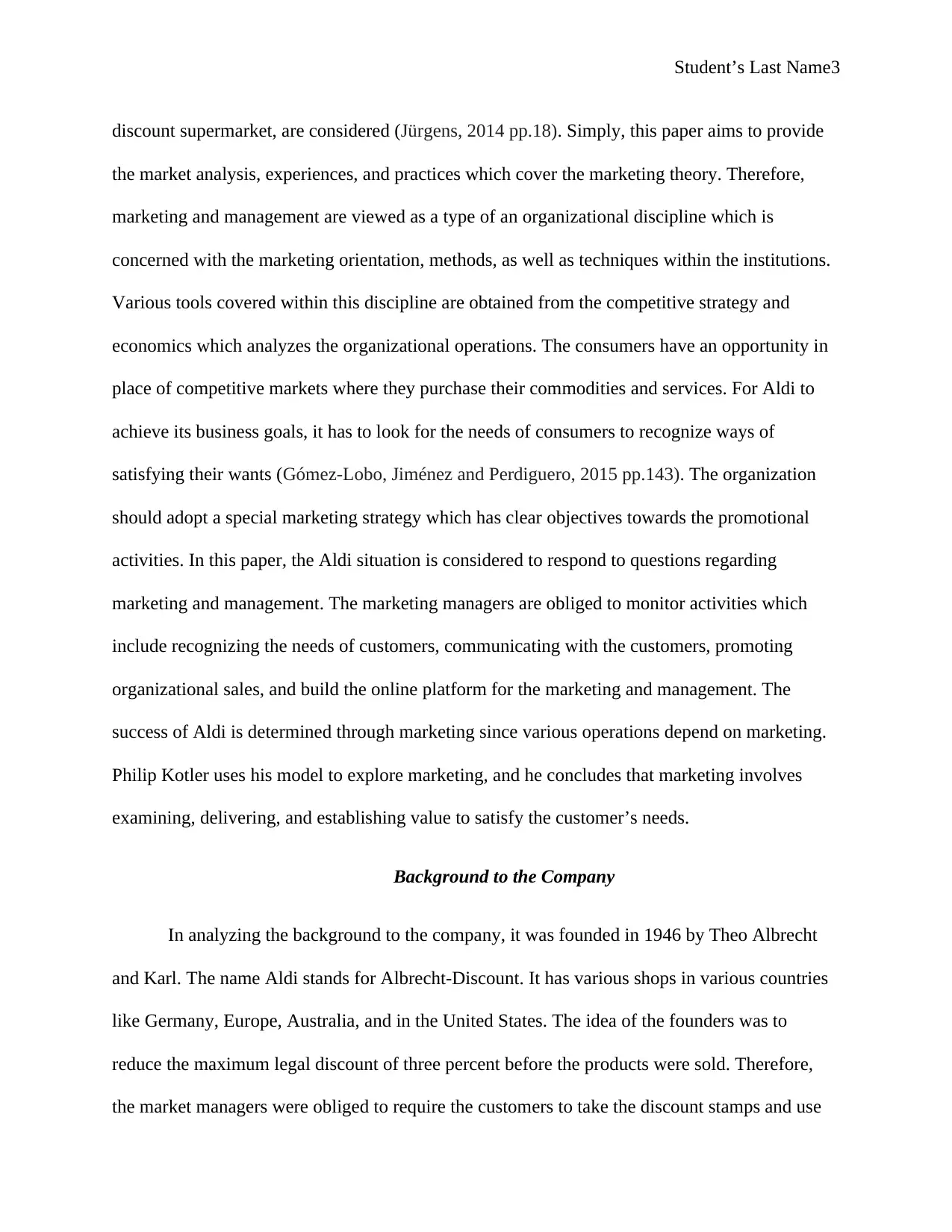
Student’s Last Name3
discount supermarket, are considered (Jürgens, 2014 pp.18). Simply, this paper aims to provide
the market analysis, experiences, and practices which cover the marketing theory. Therefore,
marketing and management are viewed as a type of an organizational discipline which is
concerned with the marketing orientation, methods, as well as techniques within the institutions.
Various tools covered within this discipline are obtained from the competitive strategy and
economics which analyzes the organizational operations. The consumers have an opportunity in
place of competitive markets where they purchase their commodities and services. For Aldi to
achieve its business goals, it has to look for the needs of consumers to recognize ways of
satisfying their wants (Gómez-Lobo, Jiménez and Perdiguero, 2015 pp.143). The organization
should adopt a special marketing strategy which has clear objectives towards the promotional
activities. In this paper, the Aldi situation is considered to respond to questions regarding
marketing and management. The marketing managers are obliged to monitor activities which
include recognizing the needs of customers, communicating with the customers, promoting
organizational sales, and build the online platform for the marketing and management. The
success of Aldi is determined through marketing since various operations depend on marketing.
Philip Kotler uses his model to explore marketing, and he concludes that marketing involves
examining, delivering, and establishing value to satisfy the customer’s needs.
Background to the Company
In analyzing the background to the company, it was founded in 1946 by Theo Albrecht
and Karl. The name Aldi stands for Albrecht-Discount. It has various shops in various countries
like Germany, Europe, Australia, and in the United States. The idea of the founders was to
reduce the maximum legal discount of three percent before the products were sold. Therefore,
the market managers were obliged to require the customers to take the discount stamps and use
discount supermarket, are considered (Jürgens, 2014 pp.18). Simply, this paper aims to provide
the market analysis, experiences, and practices which cover the marketing theory. Therefore,
marketing and management are viewed as a type of an organizational discipline which is
concerned with the marketing orientation, methods, as well as techniques within the institutions.
Various tools covered within this discipline are obtained from the competitive strategy and
economics which analyzes the organizational operations. The consumers have an opportunity in
place of competitive markets where they purchase their commodities and services. For Aldi to
achieve its business goals, it has to look for the needs of consumers to recognize ways of
satisfying their wants (Gómez-Lobo, Jiménez and Perdiguero, 2015 pp.143). The organization
should adopt a special marketing strategy which has clear objectives towards the promotional
activities. In this paper, the Aldi situation is considered to respond to questions regarding
marketing and management. The marketing managers are obliged to monitor activities which
include recognizing the needs of customers, communicating with the customers, promoting
organizational sales, and build the online platform for the marketing and management. The
success of Aldi is determined through marketing since various operations depend on marketing.
Philip Kotler uses his model to explore marketing, and he concludes that marketing involves
examining, delivering, and establishing value to satisfy the customer’s needs.
Background to the Company
In analyzing the background to the company, it was founded in 1946 by Theo Albrecht
and Karl. The name Aldi stands for Albrecht-Discount. It has various shops in various countries
like Germany, Europe, Australia, and in the United States. The idea of the founders was to
reduce the maximum legal discount of three percent before the products were sold. Therefore,
the market managers were obliged to require the customers to take the discount stamps and use
⊘ This is a preview!⊘
Do you want full access?
Subscribe today to unlock all pages.

Trusted by 1+ million students worldwide
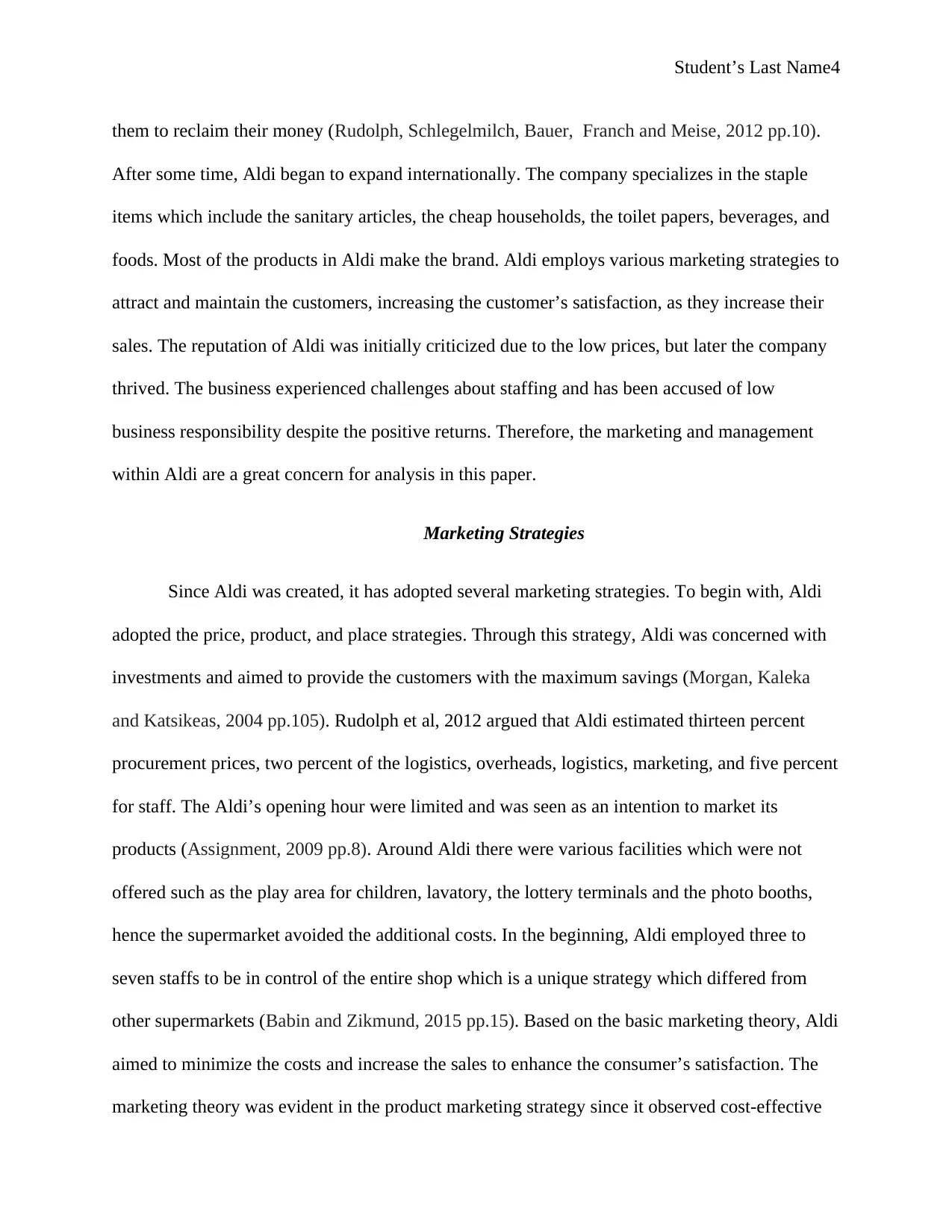
Student’s Last Name4
them to reclaim their money (Rudolph, Schlegelmilch, Bauer, Franch and Meise, 2012 pp.10).
After some time, Aldi began to expand internationally. The company specializes in the staple
items which include the sanitary articles, the cheap households, the toilet papers, beverages, and
foods. Most of the products in Aldi make the brand. Aldi employs various marketing strategies to
attract and maintain the customers, increasing the customer’s satisfaction, as they increase their
sales. The reputation of Aldi was initially criticized due to the low prices, but later the company
thrived. The business experienced challenges about staffing and has been accused of low
business responsibility despite the positive returns. Therefore, the marketing and management
within Aldi are a great concern for analysis in this paper.
Marketing Strategies
Since Aldi was created, it has adopted several marketing strategies. To begin with, Aldi
adopted the price, product, and place strategies. Through this strategy, Aldi was concerned with
investments and aimed to provide the customers with the maximum savings (Morgan, Kaleka
and Katsikeas, 2004 pp.105). Rudolph et al, 2012 argued that Aldi estimated thirteen percent
procurement prices, two percent of the logistics, overheads, logistics, marketing, and five percent
for staff. The Aldi’s opening hour were limited and was seen as an intention to market its
products (Assignment, 2009 pp.8). Around Aldi there were various facilities which were not
offered such as the play area for children, lavatory, the lottery terminals and the photo booths,
hence the supermarket avoided the additional costs. In the beginning, Aldi employed three to
seven staffs to be in control of the entire shop which is a unique strategy which differed from
other supermarkets (Babin and Zikmund, 2015 pp.15). Based on the basic marketing theory, Aldi
aimed to minimize the costs and increase the sales to enhance the consumer’s satisfaction. The
marketing theory was evident in the product marketing strategy since it observed cost-effective
them to reclaim their money (Rudolph, Schlegelmilch, Bauer, Franch and Meise, 2012 pp.10).
After some time, Aldi began to expand internationally. The company specializes in the staple
items which include the sanitary articles, the cheap households, the toilet papers, beverages, and
foods. Most of the products in Aldi make the brand. Aldi employs various marketing strategies to
attract and maintain the customers, increasing the customer’s satisfaction, as they increase their
sales. The reputation of Aldi was initially criticized due to the low prices, but later the company
thrived. The business experienced challenges about staffing and has been accused of low
business responsibility despite the positive returns. Therefore, the marketing and management
within Aldi are a great concern for analysis in this paper.
Marketing Strategies
Since Aldi was created, it has adopted several marketing strategies. To begin with, Aldi
adopted the price, product, and place strategies. Through this strategy, Aldi was concerned with
investments and aimed to provide the customers with the maximum savings (Morgan, Kaleka
and Katsikeas, 2004 pp.105). Rudolph et al, 2012 argued that Aldi estimated thirteen percent
procurement prices, two percent of the logistics, overheads, logistics, marketing, and five percent
for staff. The Aldi’s opening hour were limited and was seen as an intention to market its
products (Assignment, 2009 pp.8). Around Aldi there were various facilities which were not
offered such as the play area for children, lavatory, the lottery terminals and the photo booths,
hence the supermarket avoided the additional costs. In the beginning, Aldi employed three to
seven staffs to be in control of the entire shop which is a unique strategy which differed from
other supermarkets (Babin and Zikmund, 2015 pp.15). Based on the basic marketing theory, Aldi
aimed to minimize the costs and increase the sales to enhance the consumer’s satisfaction. The
marketing theory was evident in the product marketing strategy since it observed cost-effective
Paraphrase This Document
Need a fresh take? Get an instant paraphrase of this document with our AI Paraphraser
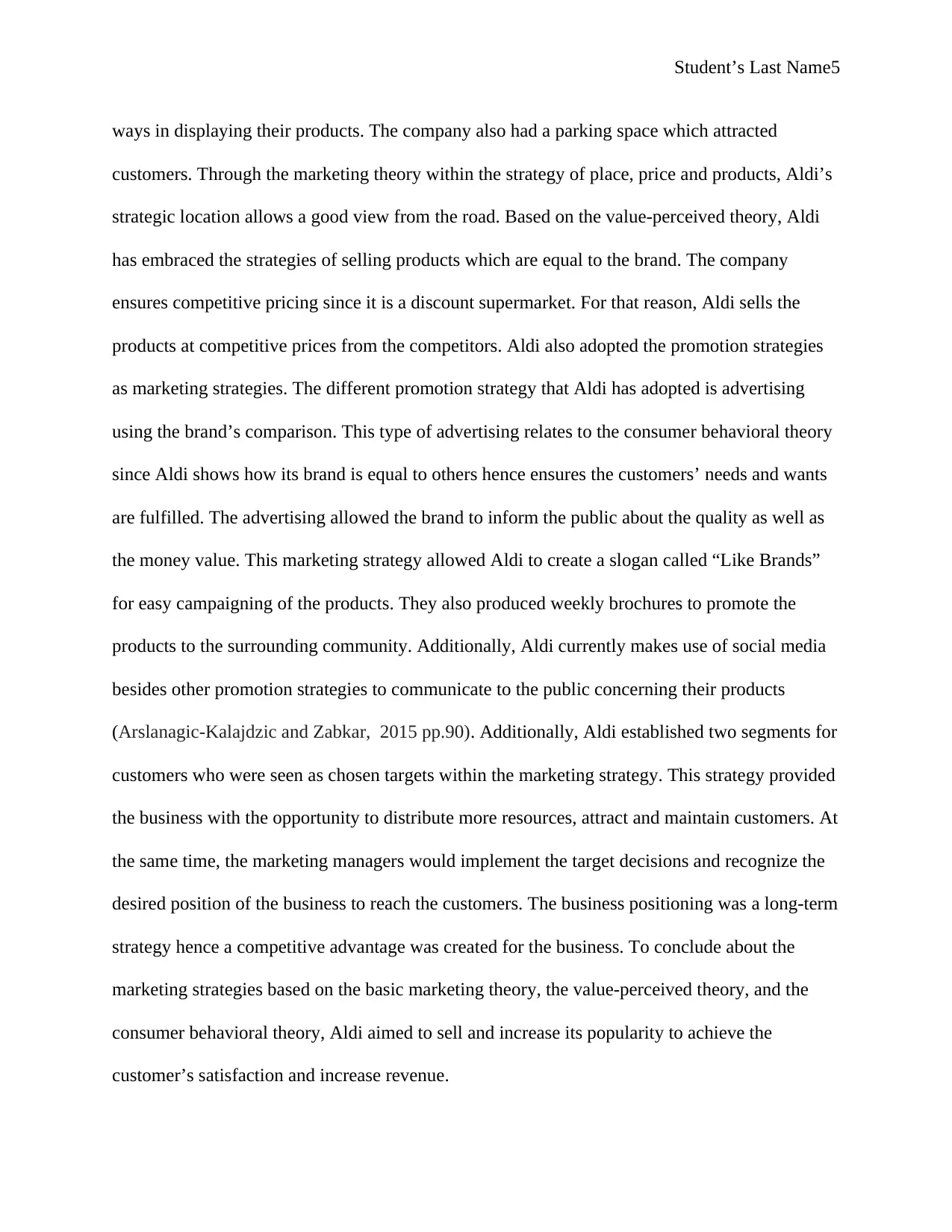
Student’s Last Name5
ways in displaying their products. The company also had a parking space which attracted
customers. Through the marketing theory within the strategy of place, price and products, Aldi’s
strategic location allows a good view from the road. Based on the value-perceived theory, Aldi
has embraced the strategies of selling products which are equal to the brand. The company
ensures competitive pricing since it is a discount supermarket. For that reason, Aldi sells the
products at competitive prices from the competitors. Aldi also adopted the promotion strategies
as marketing strategies. The different promotion strategy that Aldi has adopted is advertising
using the brand’s comparison. This type of advertising relates to the consumer behavioral theory
since Aldi shows how its brand is equal to others hence ensures the customers’ needs and wants
are fulfilled. The advertising allowed the brand to inform the public about the quality as well as
the money value. This marketing strategy allowed Aldi to create a slogan called “Like Brands”
for easy campaigning of the products. They also produced weekly brochures to promote the
products to the surrounding community. Additionally, Aldi currently makes use of social media
besides other promotion strategies to communicate to the public concerning their products
(Arslanagic-Kalajdzic and Zabkar, 2015 pp.90). Additionally, Aldi established two segments for
customers who were seen as chosen targets within the marketing strategy. This strategy provided
the business with the opportunity to distribute more resources, attract and maintain customers. At
the same time, the marketing managers would implement the target decisions and recognize the
desired position of the business to reach the customers. The business positioning was a long-term
strategy hence a competitive advantage was created for the business. To conclude about the
marketing strategies based on the basic marketing theory, the value-perceived theory, and the
consumer behavioral theory, Aldi aimed to sell and increase its popularity to achieve the
customer’s satisfaction and increase revenue.
ways in displaying their products. The company also had a parking space which attracted
customers. Through the marketing theory within the strategy of place, price and products, Aldi’s
strategic location allows a good view from the road. Based on the value-perceived theory, Aldi
has embraced the strategies of selling products which are equal to the brand. The company
ensures competitive pricing since it is a discount supermarket. For that reason, Aldi sells the
products at competitive prices from the competitors. Aldi also adopted the promotion strategies
as marketing strategies. The different promotion strategy that Aldi has adopted is advertising
using the brand’s comparison. This type of advertising relates to the consumer behavioral theory
since Aldi shows how its brand is equal to others hence ensures the customers’ needs and wants
are fulfilled. The advertising allowed the brand to inform the public about the quality as well as
the money value. This marketing strategy allowed Aldi to create a slogan called “Like Brands”
for easy campaigning of the products. They also produced weekly brochures to promote the
products to the surrounding community. Additionally, Aldi currently makes use of social media
besides other promotion strategies to communicate to the public concerning their products
(Arslanagic-Kalajdzic and Zabkar, 2015 pp.90). Additionally, Aldi established two segments for
customers who were seen as chosen targets within the marketing strategy. This strategy provided
the business with the opportunity to distribute more resources, attract and maintain customers. At
the same time, the marketing managers would implement the target decisions and recognize the
desired position of the business to reach the customers. The business positioning was a long-term
strategy hence a competitive advantage was created for the business. To conclude about the
marketing strategies based on the basic marketing theory, the value-perceived theory, and the
consumer behavioral theory, Aldi aimed to sell and increase its popularity to achieve the
customer’s satisfaction and increase revenue.
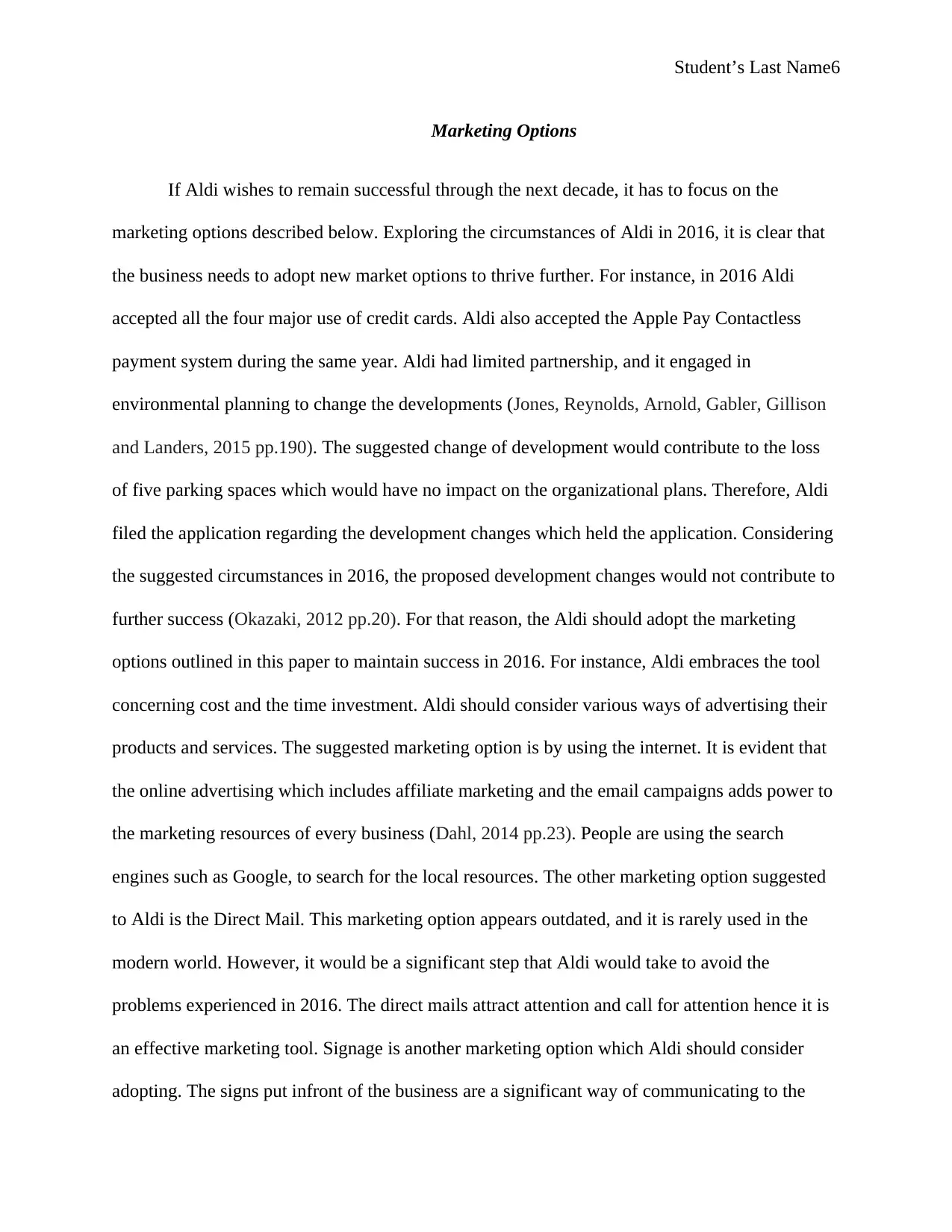
Student’s Last Name6
Marketing Options
If Aldi wishes to remain successful through the next decade, it has to focus on the
marketing options described below. Exploring the circumstances of Aldi in 2016, it is clear that
the business needs to adopt new market options to thrive further. For instance, in 2016 Aldi
accepted all the four major use of credit cards. Aldi also accepted the Apple Pay Contactless
payment system during the same year. Aldi had limited partnership, and it engaged in
environmental planning to change the developments (Jones, Reynolds, Arnold, Gabler, Gillison
and Landers, 2015 pp.190). The suggested change of development would contribute to the loss
of five parking spaces which would have no impact on the organizational plans. Therefore, Aldi
filed the application regarding the development changes which held the application. Considering
the suggested circumstances in 2016, the proposed development changes would not contribute to
further success (Okazaki, 2012 pp.20). For that reason, the Aldi should adopt the marketing
options outlined in this paper to maintain success in 2016. For instance, Aldi embraces the tool
concerning cost and the time investment. Aldi should consider various ways of advertising their
products and services. The suggested marketing option is by using the internet. It is evident that
the online advertising which includes affiliate marketing and the email campaigns adds power to
the marketing resources of every business (Dahl, 2014 pp.23). People are using the search
engines such as Google, to search for the local resources. The other marketing option suggested
to Aldi is the Direct Mail. This marketing option appears outdated, and it is rarely used in the
modern world. However, it would be a significant step that Aldi would take to avoid the
problems experienced in 2016. The direct mails attract attention and call for attention hence it is
an effective marketing tool. Signage is another marketing option which Aldi should consider
adopting. The signs put infront of the business are a significant way of communicating to the
Marketing Options
If Aldi wishes to remain successful through the next decade, it has to focus on the
marketing options described below. Exploring the circumstances of Aldi in 2016, it is clear that
the business needs to adopt new market options to thrive further. For instance, in 2016 Aldi
accepted all the four major use of credit cards. Aldi also accepted the Apple Pay Contactless
payment system during the same year. Aldi had limited partnership, and it engaged in
environmental planning to change the developments (Jones, Reynolds, Arnold, Gabler, Gillison
and Landers, 2015 pp.190). The suggested change of development would contribute to the loss
of five parking spaces which would have no impact on the organizational plans. Therefore, Aldi
filed the application regarding the development changes which held the application. Considering
the suggested circumstances in 2016, the proposed development changes would not contribute to
further success (Okazaki, 2012 pp.20). For that reason, the Aldi should adopt the marketing
options outlined in this paper to maintain success in 2016. For instance, Aldi embraces the tool
concerning cost and the time investment. Aldi should consider various ways of advertising their
products and services. The suggested marketing option is by using the internet. It is evident that
the online advertising which includes affiliate marketing and the email campaigns adds power to
the marketing resources of every business (Dahl, 2014 pp.23). People are using the search
engines such as Google, to search for the local resources. The other marketing option suggested
to Aldi is the Direct Mail. This marketing option appears outdated, and it is rarely used in the
modern world. However, it would be a significant step that Aldi would take to avoid the
problems experienced in 2016. The direct mails attract attention and call for attention hence it is
an effective marketing tool. Signage is another marketing option which Aldi should consider
adopting. The signs put infront of the business are a significant way of communicating to the
⊘ This is a preview!⊘
Do you want full access?
Subscribe today to unlock all pages.

Trusted by 1+ million students worldwide
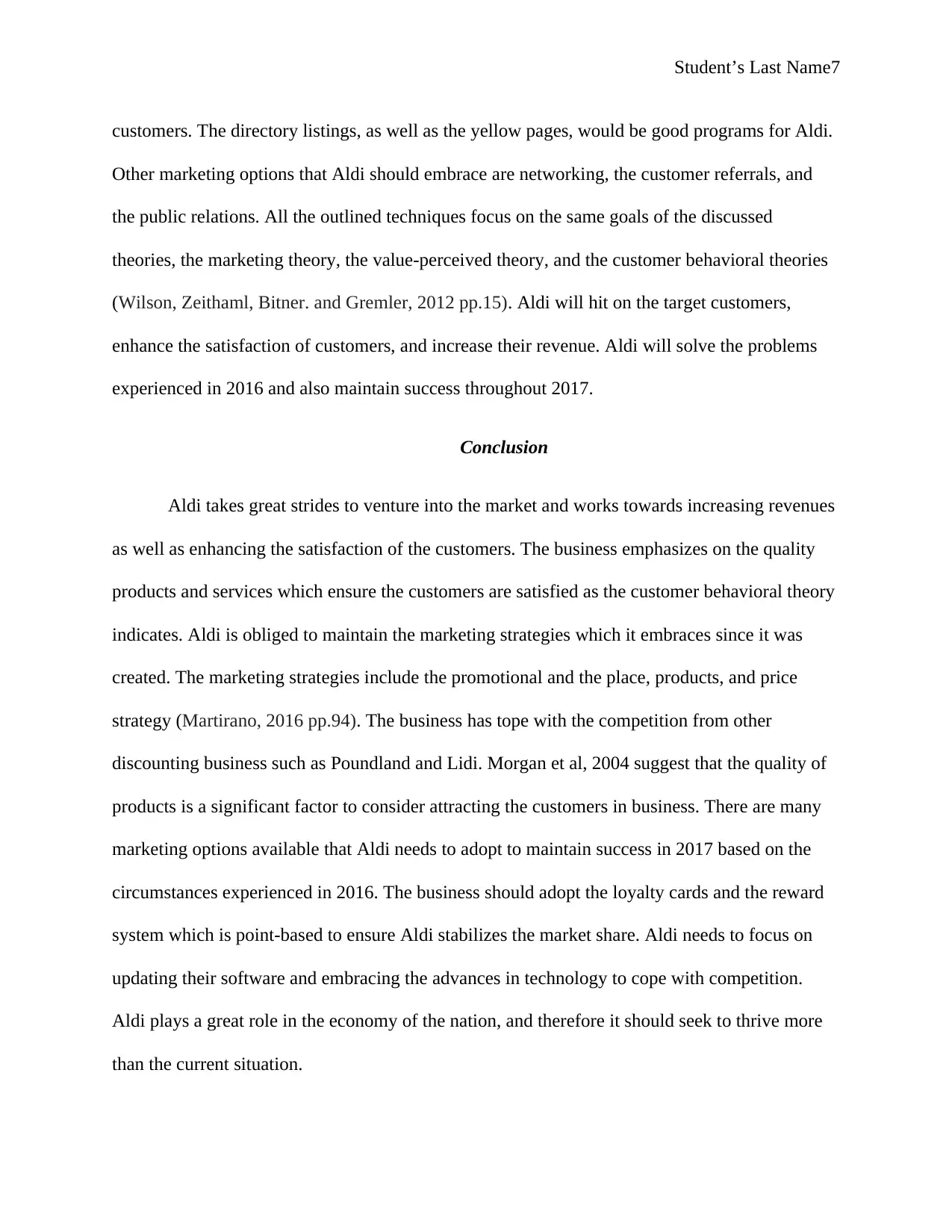
Student’s Last Name7
customers. The directory listings, as well as the yellow pages, would be good programs for Aldi.
Other marketing options that Aldi should embrace are networking, the customer referrals, and
the public relations. All the outlined techniques focus on the same goals of the discussed
theories, the marketing theory, the value-perceived theory, and the customer behavioral theories
(Wilson, Zeithaml, Bitner. and Gremler, 2012 pp.15). Aldi will hit on the target customers,
enhance the satisfaction of customers, and increase their revenue. Aldi will solve the problems
experienced in 2016 and also maintain success throughout 2017.
Conclusion
Aldi takes great strides to venture into the market and works towards increasing revenues
as well as enhancing the satisfaction of the customers. The business emphasizes on the quality
products and services which ensure the customers are satisfied as the customer behavioral theory
indicates. Aldi is obliged to maintain the marketing strategies which it embraces since it was
created. The marketing strategies include the promotional and the place, products, and price
strategy (Martirano, 2016 pp.94). The business has tope with the competition from other
discounting business such as Poundland and Lidi. Morgan et al, 2004 suggest that the quality of
products is a significant factor to consider attracting the customers in business. There are many
marketing options available that Aldi needs to adopt to maintain success in 2017 based on the
circumstances experienced in 2016. The business should adopt the loyalty cards and the reward
system which is point-based to ensure Aldi stabilizes the market share. Aldi needs to focus on
updating their software and embracing the advances in technology to cope with competition.
Aldi plays a great role in the economy of the nation, and therefore it should seek to thrive more
than the current situation.
customers. The directory listings, as well as the yellow pages, would be good programs for Aldi.
Other marketing options that Aldi should embrace are networking, the customer referrals, and
the public relations. All the outlined techniques focus on the same goals of the discussed
theories, the marketing theory, the value-perceived theory, and the customer behavioral theories
(Wilson, Zeithaml, Bitner. and Gremler, 2012 pp.15). Aldi will hit on the target customers,
enhance the satisfaction of customers, and increase their revenue. Aldi will solve the problems
experienced in 2016 and also maintain success throughout 2017.
Conclusion
Aldi takes great strides to venture into the market and works towards increasing revenues
as well as enhancing the satisfaction of the customers. The business emphasizes on the quality
products and services which ensure the customers are satisfied as the customer behavioral theory
indicates. Aldi is obliged to maintain the marketing strategies which it embraces since it was
created. The marketing strategies include the promotional and the place, products, and price
strategy (Martirano, 2016 pp.94). The business has tope with the competition from other
discounting business such as Poundland and Lidi. Morgan et al, 2004 suggest that the quality of
products is a significant factor to consider attracting the customers in business. There are many
marketing options available that Aldi needs to adopt to maintain success in 2017 based on the
circumstances experienced in 2016. The business should adopt the loyalty cards and the reward
system which is point-based to ensure Aldi stabilizes the market share. Aldi needs to focus on
updating their software and embracing the advances in technology to cope with competition.
Aldi plays a great role in the economy of the nation, and therefore it should seek to thrive more
than the current situation.
Paraphrase This Document
Need a fresh take? Get an instant paraphrase of this document with our AI Paraphraser
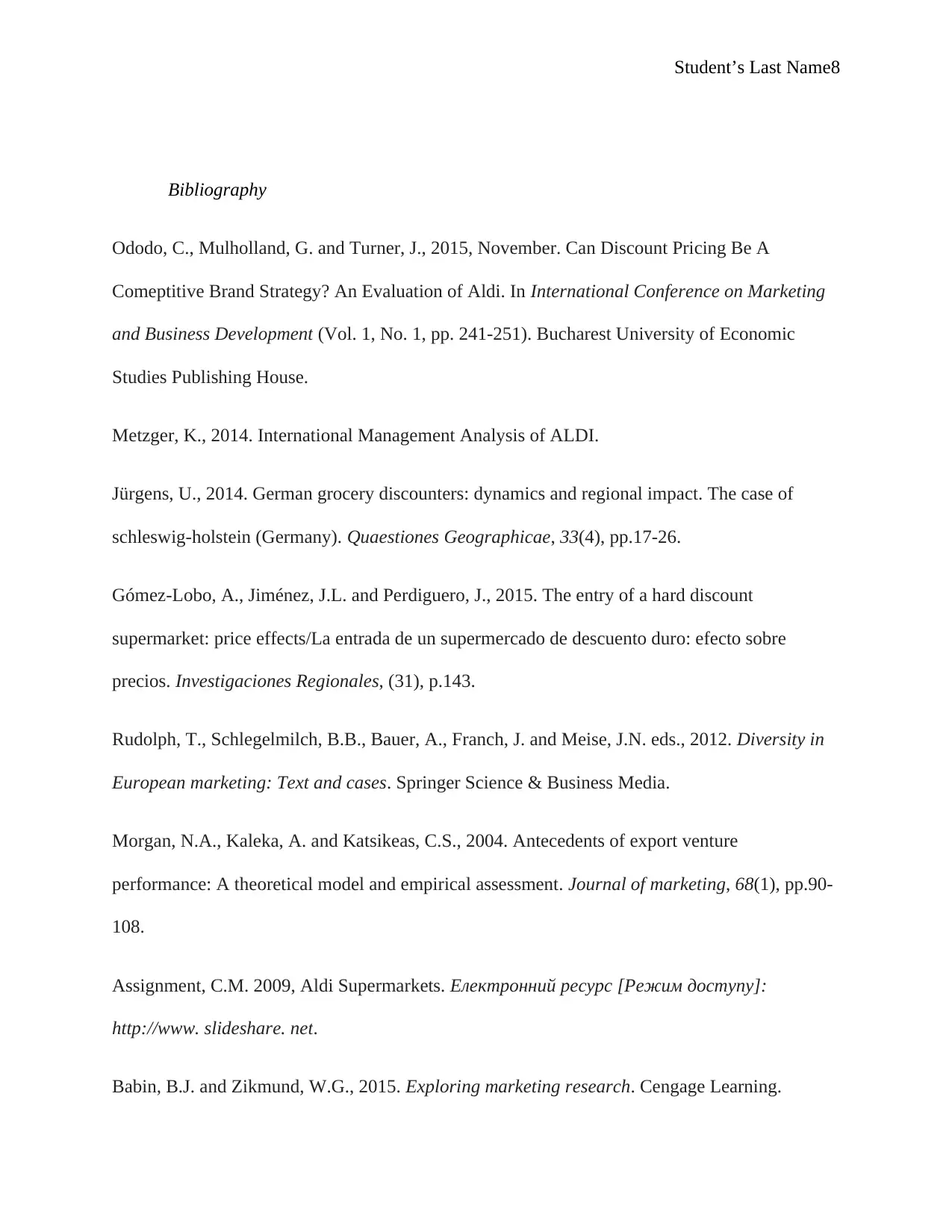
Student’s Last Name8
Bibliography
Ododo, C., Mulholland, G. and Turner, J., 2015, November. Can Discount Pricing Be A
Comeptitive Brand Strategy? An Evaluation of Aldi. In International Conference on Marketing
and Business Development (Vol. 1, No. 1, pp. 241-251). Bucharest University of Economic
Studies Publishing House.
Metzger, K., 2014. International Management Analysis of ALDI.
Jürgens, U., 2014. German grocery discounters: dynamics and regional impact. The case of
schleswig-holstein (Germany). Quaestiones Geographicae, 33(4), pp.17-26.
Gómez-Lobo, A., Jiménez, J.L. and Perdiguero, J., 2015. The entry of a hard discount
supermarket: price effects/La entrada de un supermercado de descuento duro: efecto sobre
precios. Investigaciones Regionales, (31), p.143.
Rudolph, T., Schlegelmilch, B.B., Bauer, A., Franch, J. and Meise, J.N. eds., 2012. Diversity in
European marketing: Text and cases. Springer Science & Business Media.
Morgan, N.A., Kaleka, A. and Katsikeas, C.S., 2004. Antecedents of export venture
performance: A theoretical model and empirical assessment. Journal of marketing, 68(1), pp.90-
108.
Assignment, C.M. 2009, Aldi Supermarkets. Електронний ресурс [Режим доступу]:
http://www. slideshare. net.
Babin, B.J. and Zikmund, W.G., 2015. Exploring marketing research. Cengage Learning.
Bibliography
Ododo, C., Mulholland, G. and Turner, J., 2015, November. Can Discount Pricing Be A
Comeptitive Brand Strategy? An Evaluation of Aldi. In International Conference on Marketing
and Business Development (Vol. 1, No. 1, pp. 241-251). Bucharest University of Economic
Studies Publishing House.
Metzger, K., 2014. International Management Analysis of ALDI.
Jürgens, U., 2014. German grocery discounters: dynamics and regional impact. The case of
schleswig-holstein (Germany). Quaestiones Geographicae, 33(4), pp.17-26.
Gómez-Lobo, A., Jiménez, J.L. and Perdiguero, J., 2015. The entry of a hard discount
supermarket: price effects/La entrada de un supermercado de descuento duro: efecto sobre
precios. Investigaciones Regionales, (31), p.143.
Rudolph, T., Schlegelmilch, B.B., Bauer, A., Franch, J. and Meise, J.N. eds., 2012. Diversity in
European marketing: Text and cases. Springer Science & Business Media.
Morgan, N.A., Kaleka, A. and Katsikeas, C.S., 2004. Antecedents of export venture
performance: A theoretical model and empirical assessment. Journal of marketing, 68(1), pp.90-
108.
Assignment, C.M. 2009, Aldi Supermarkets. Електронний ресурс [Режим доступу]:
http://www. slideshare. net.
Babin, B.J. and Zikmund, W.G., 2015. Exploring marketing research. Cengage Learning.
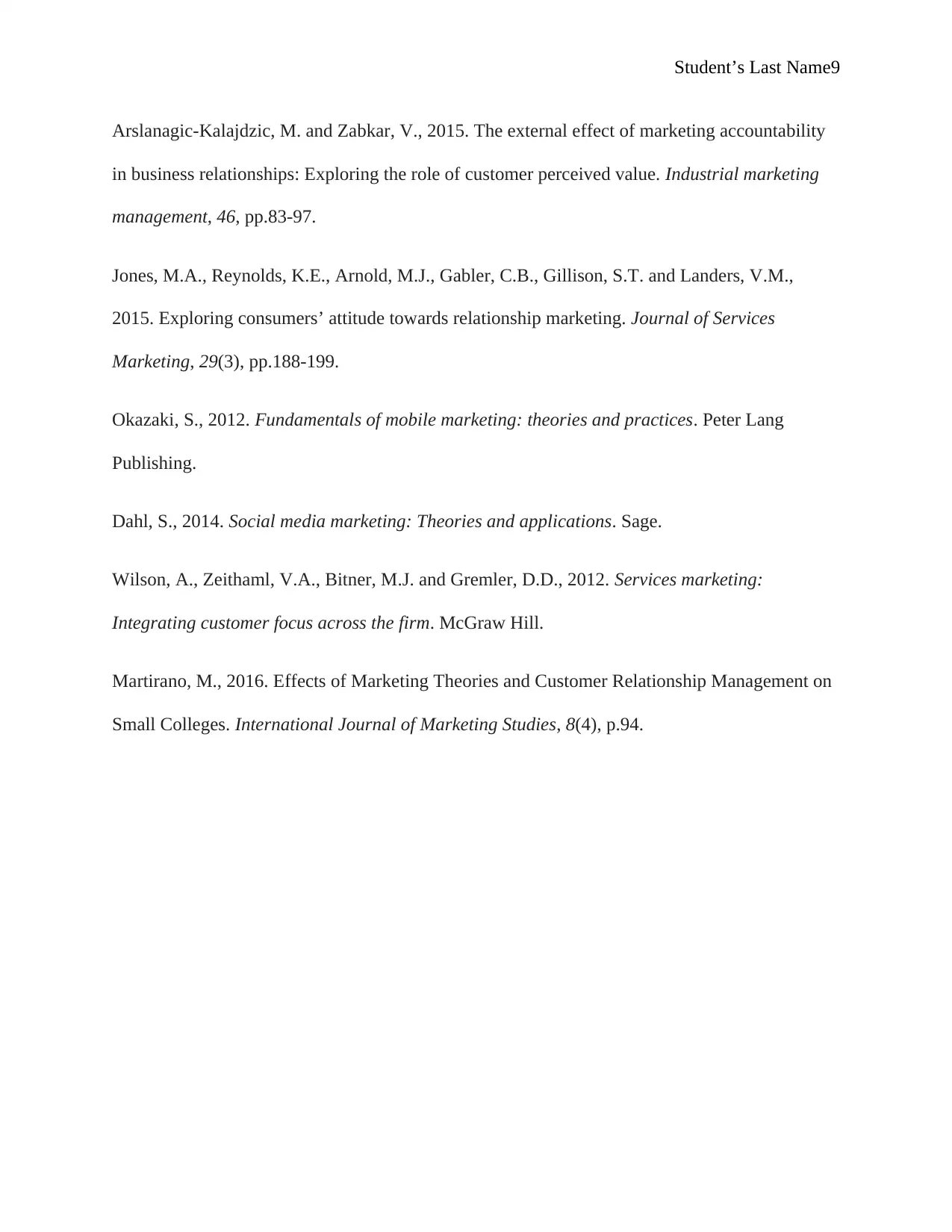
Student’s Last Name9
Arslanagic-Kalajdzic, M. and Zabkar, V., 2015. The external effect of marketing accountability
in business relationships: Exploring the role of customer perceived value. Industrial marketing
management, 46, pp.83-97.
Jones, M.A., Reynolds, K.E., Arnold, M.J., Gabler, C.B., Gillison, S.T. and Landers, V.M.,
2015. Exploring consumers’ attitude towards relationship marketing. Journal of Services
Marketing, 29(3), pp.188-199.
Okazaki, S., 2012. Fundamentals of mobile marketing: theories and practices. Peter Lang
Publishing.
Dahl, S., 2014. Social media marketing: Theories and applications. Sage.
Wilson, A., Zeithaml, V.A., Bitner, M.J. and Gremler, D.D., 2012. Services marketing:
Integrating customer focus across the firm. McGraw Hill.
Martirano, M., 2016. Effects of Marketing Theories and Customer Relationship Management on
Small Colleges. International Journal of Marketing Studies, 8(4), p.94.
Arslanagic-Kalajdzic, M. and Zabkar, V., 2015. The external effect of marketing accountability
in business relationships: Exploring the role of customer perceived value. Industrial marketing
management, 46, pp.83-97.
Jones, M.A., Reynolds, K.E., Arnold, M.J., Gabler, C.B., Gillison, S.T. and Landers, V.M.,
2015. Exploring consumers’ attitude towards relationship marketing. Journal of Services
Marketing, 29(3), pp.188-199.
Okazaki, S., 2012. Fundamentals of mobile marketing: theories and practices. Peter Lang
Publishing.
Dahl, S., 2014. Social media marketing: Theories and applications. Sage.
Wilson, A., Zeithaml, V.A., Bitner, M.J. and Gremler, D.D., 2012. Services marketing:
Integrating customer focus across the firm. McGraw Hill.
Martirano, M., 2016. Effects of Marketing Theories and Customer Relationship Management on
Small Colleges. International Journal of Marketing Studies, 8(4), p.94.
⊘ This is a preview!⊘
Do you want full access?
Subscribe today to unlock all pages.

Trusted by 1+ million students worldwide
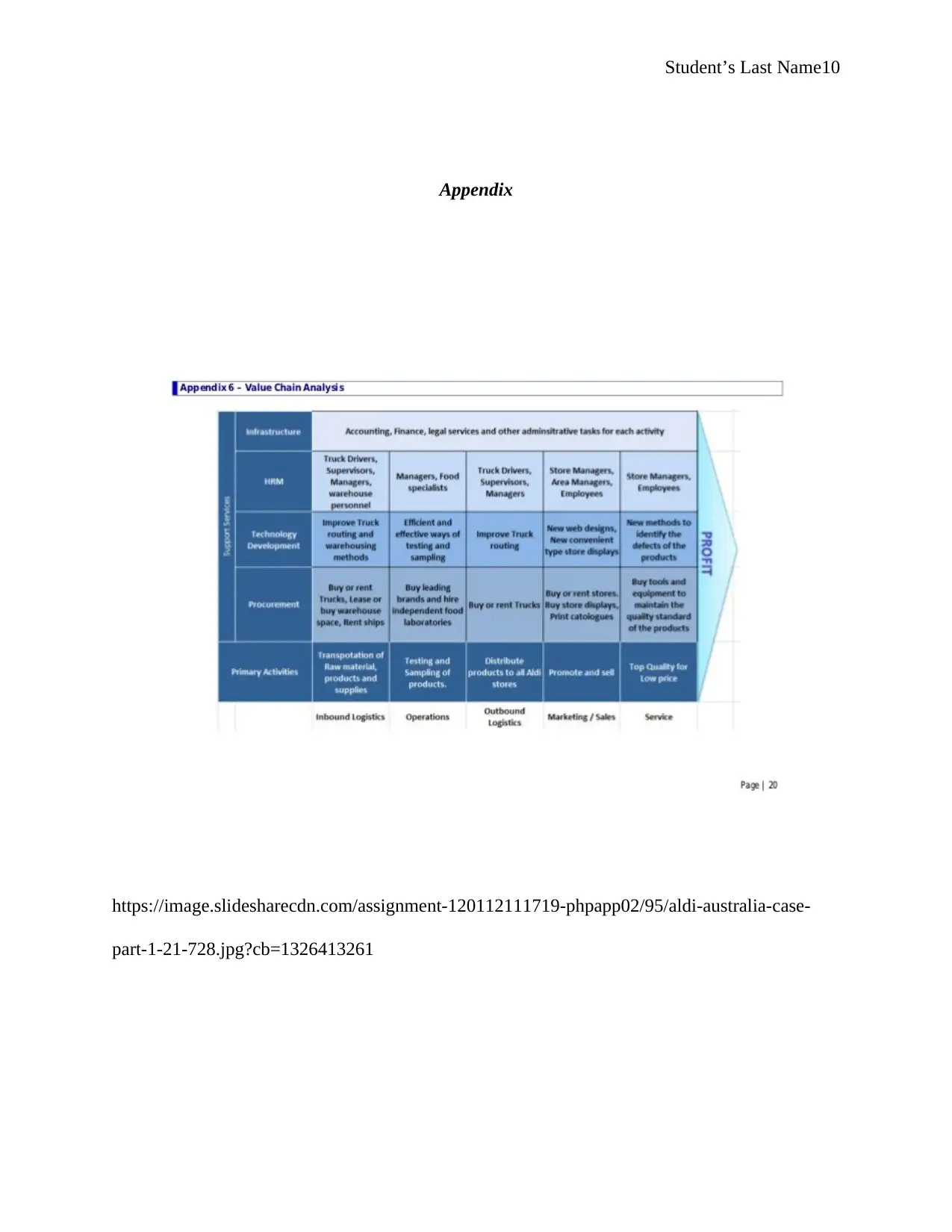
Student’s Last Name10
Appendix
https://image.slidesharecdn.com/assignment-120112111719-phpapp02/95/aldi-australia-case-
part-1-21-728.jpg?cb=1326413261
Appendix
https://image.slidesharecdn.com/assignment-120112111719-phpapp02/95/aldi-australia-case-
part-1-21-728.jpg?cb=1326413261
1 out of 10
Related Documents
Your All-in-One AI-Powered Toolkit for Academic Success.
+13062052269
info@desklib.com
Available 24*7 on WhatsApp / Email
![[object Object]](/_next/static/media/star-bottom.7253800d.svg)
Unlock your academic potential
Copyright © 2020–2025 A2Z Services. All Rights Reserved. Developed and managed by ZUCOL.





